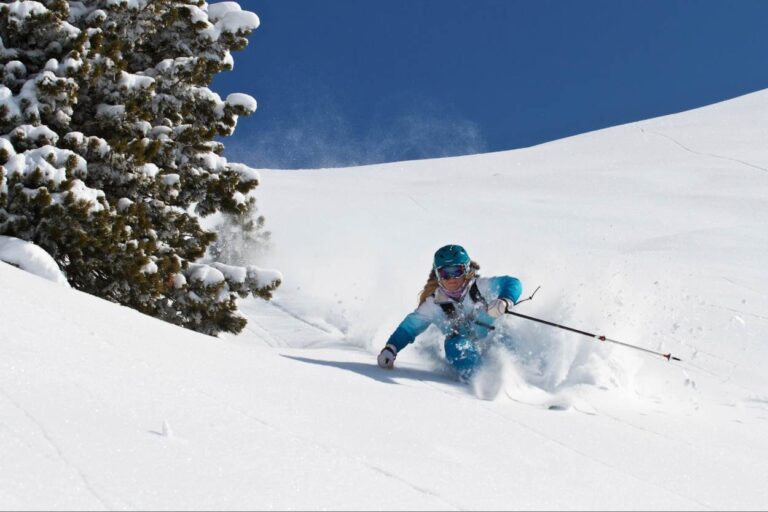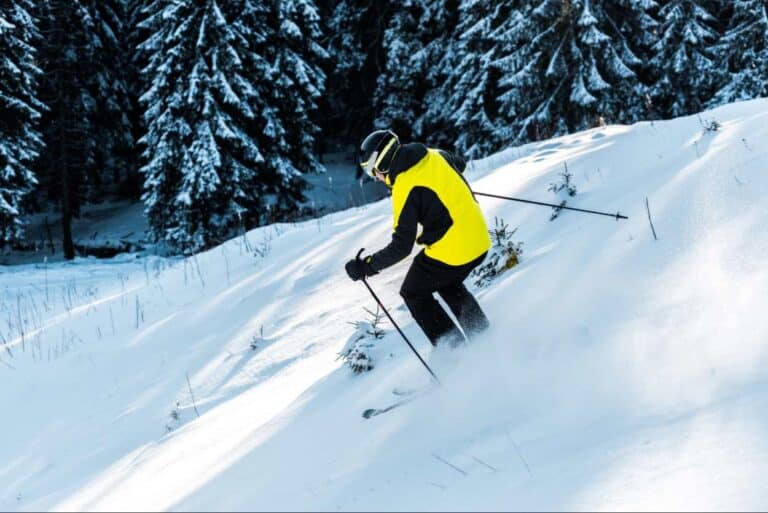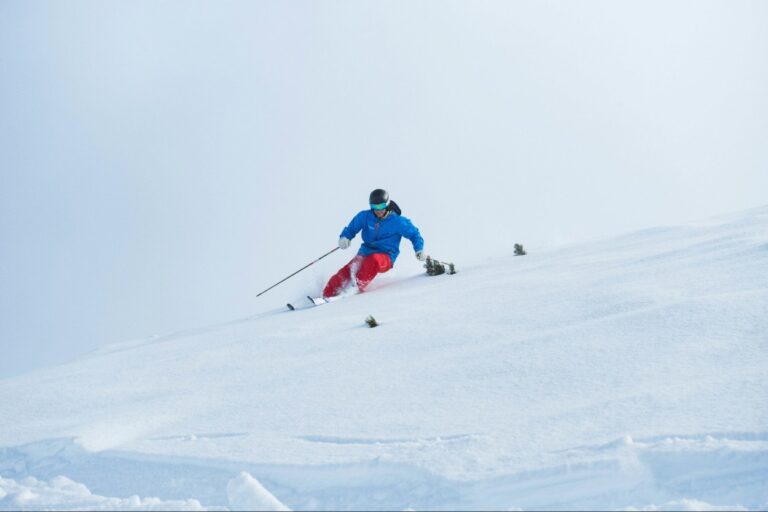There’s something magnetic about looking beyond the perfectly groomed pistes, where the snow lies untouched and the mountains reveal their wilder side. For many skiers, this thrill is a path that must be sought: the urge to venture off-piste. It’s goes beyond standard skiing incorporating exploration, freedom, and challenge rolled into one.
But it’s not a step to be taken lightly. Off-piste skiing demands a different mindset, fresh skills, the right equipment, and a strong respect for the mountain environment. Done properly, it’s exhilarating. Done carelessly, it can be dangerous.
If you’ve conquered red runs, pushed your technique on mogul skiing, and now crave the next competitive edge, here’s your complete guide to what off-piste skiing is all about.
Off-piste skiing – an overview
At its simplest, off-piste skiing means leaving the marked, maintained slopes and heading into natural snow. No grooming machines. No piste markers. Just you, your skis, and the mountain.
For most, it’s chasing powder fields after a fresh dump of snow. For the more extreme, it’s tackling steep couloirs or long descents into valleys untouched by lifts. The appeal? Taking the less trodden path and pushing your ability to new boundaries.
Skiing vs. Off-piste skiing: Key Differences

If piste skiing is like running a race on a well-marked athletics track, off-piste is more akin to trail running or cross-country – scenic, unpredictable, and far less forgiving. The sense of adventure is far greater, but so too is the need for skill and respect.
Terrain
On-piste, slopes are groomed every night, smoothing out lumps and refreshing the corduroy surface we all know. The runs are clearly marked, graded by colour, and designed to flow.
Off-piste, the mountain is in its natural state. Snow can be waist-deep powder one day and wind-scoured crust the next. Obstacles, including rocks, tree stumps, streams, even hidden cliffs, are part of the challenge. There are no piste markers to guide you, only your eye for a line.
Conditions
Pistes are generally predictable. You know roughly what to expect, even by mid-afternoon when they’re a bit chopped up.
Off-piste, conditions change with every turn. A shaded north face can hold soft snow while a sun-exposed slope just metres away could be heavy slush. Temperature, wind, and sun exposure all sculpt the snowpack — and your job is to adapt on the fly.
Risk Factors
On-piste skiing benefits from constant resort management: avalanche control, patrolling, and first aid teams. If you fall, help isn’t far away.
Beyond the pistes, you are responsible for yourself. You could face avalanches, tree wells, where you can get trapped beneath branches; hidden crevasses on glaciers; or simply getting lost in poor visibility. Even a minor injury can become serious when you’re far from help.
Skills Required
Strong piste technique is essential but not sufficient. Carving clean turns on corduroy doesn’t automatically translate into skiing knee-deep powder.
Off-piste skiing demands:
Adaptability: Reading and responding to varied snow conditions.
Stamina: Skiing off-piste is physically draining — your legs will burn faster than on a groomed slope.
Decision-making under pressure: Choosing safe lines, judging snow stability, and sometimes deciding not to ski a slope at all.
Mountain sense: Understanding terrain, weather, and avalanche warnings as much as technical skill.
The essence
On-piste skiing is the sport of technique, precision, and progression. Off-piste takes that and adds exploration, self-reliance, and adventure. It’s skiing in its rawest form – thrilling, unpredictable, and deeply rewarding for those ready to take it on.
Preparation and planning: Success starts before the first turn
The best off-piste runs don’t begin on the snow; they begin with preparation.
- Research the area: Study maps, talk to locals, and check whether guides are available.
- Check the forecast: Weather patterns dictate avalanche risk and snow conditions.
- Read avalanche bulletins: Most alpine regions publish daily updates. Get used to reading and interpreting them.
- Be honest about fitness and skill: Off-piste is physically demanding — skiing deep snow requires leg strength and stamina.
- Consider going with a guide: Especially at first, it’s the safest and most rewarding way to learn.
Preparation isn’t about dampening the spirit of adventure — it’s what allows you to ski harder, further, and with confidence.
What you need for off-piste skiing
A lift pass and your standard piste skis won’t cut it once you step off the beaten track. You’ll want to have:
- Off-piste skis: You’ll want either an all-mountain skis or wider skis (sometimes called freeride skis) float better in powder.
- Avalanche kit: A working transceiver, shovel, and probe are non-negotiable. You’ll also need to know how to use this equipment.
- Backpack: Many freeriders also use avalanche airbag packs, which can increase survival chances if caught in a slide.
- Clothing: Layer smartly. Off-piste often means getting hot uphill (hiking and sweating) then getting cold (skiing through cold descents).
- Helmet and goggles: With visibility and protection more important than ever.
- Extras: A hydration system, snacks, spare gloves, and a first aid kit — small things that make a big difference.
Think of gear as your competitive edge: without the right kit, you’re handicapping yourself before you even push off.
Types of snow and how to adapt

One of the biggest challenges, and joys, of off-piste skiing is that the snow is never the same twice. One descent can be silky smooth, the next a complete battle. Learning to recognise different snow types and adapt your technique is the mark of a true freerider.
Powder
The stuff of dreams. Light, fluffy snow that billows around you as you ski, giving that effortless, floating sensation. Powder rewards a centred stance and gentle, even weight distribution on both skis. Think rhythm rather than force: bounce lightly, let the skis rise and fall, and resist the temptation to lean back. Once you find the flow, it’s the purest joy in skiing.
Crust
Crust forms when the top layer melts slightly and then refreeze, leaving a hard shell over softer snow beneath. Breaking through it can be awkward; your skis may dive suddenly or catch unpredictably. The trick is light, controlled turns and staying centred so you don’t get thrown off balance. Short, committed turns help punch through the layer without catching an edge.
Slush
Most common in spring, slush is wet, heavy snow that clings to your skis and slows you down. It requires more powerful movements and shorter turns to maintain rhythm and momentum. Keep your weight slightly forward and drive through the snow — think of it as a strength session on skis.
Crud
Crud is what powder becomes after others have skied it: uneven, chopped-up, and unpredictable. It’s not glamorous, but learning to master crud is essential. Ski aggressively, stay forward on your skis, and commit to each turn. If you’re tentative, crud will throw you around. Strong legs and a positive attitude go a long way here.
Ice
Icy sections are often unavoidable, particularly on wind-blown ridges or exposed slopes. They’re unforgiving — your edges either grip or they don’t. Keep your edges razor-sharp, stay calm, and use precise, balanced turns. On ice, it’s about control, not flair.
Mastering variable snow isn’t just survival. It’s what separates competitive, adaptable skiers from those who can only shine on corduroy pistes. Each condition is a chance to sharpen a different aspect of your skiing.
Techniques for off-piste skiing

Even confident piste skiers need to rethink their style once they step into the wild snow. The fundamentals shift: balance, control, and terrain reading all take on new levels of importance.
Stay centred
The classic beginner’s mistake is to lean back in deep snow to stop the tips from diving. This actually makes control harder. Stay centred over your skis, with ankles, knees, and hips stacked. A balanced stance keeps you reactive and ready for anything the terrain throws at you.
Short turns
Long carving arcs might look elegant on piste, but in deep snow or tight couloirs, they’ll sap your energy and leave you stuck. Develop quick, short-radius turns — using a strong pole plant and a snappy rhythm. They give you control, conserve energy, and let you react fast when conditions change.
Read the terrain
Off-piste skiing is as much about your eyes as your legs. Scan constantly ahead for avalanche risk, rocks, cliffs, or sudden changes in snow. Look for natural lines that flow, avoid convex rolls (which often hide danger), and think two or three turns ahead. Terrain reading is a skill that grows with practice and it’s what keeps you both safe and efficient.
Use natural features
The mountain gives clues and advantages if you know where to look. Ridges can offer safer lines with less avalanche risk. Tree lines provide better visibility in flat light and often hold lighter snow. Gullies funnel snow and can create great powder stashes, though they also need careful safety judgement. Work with the terrain, not against it.
Save energy
Off-piste skiing is a leg-burner. A single long powder run can leave even fit skiers gasping. Efficiency is key: keep movements smooth, avoid fighting the snow, and let gravity do the work. Skiing with flow not only looks good – it means you’ll have the stamina to ski again tomorrow.
The mindset
Above all, off-piste skiing demands the right mindset. Ski with intent, commit to your line, and don’t be tentative. But balance that aggression with humility: the mountain always has the last word. Ski hard but never let ego overrule judgement.
Safety considerations: Respect the mountain
Off-piste skiing is as much about risk management as it is about skill. Safety is non-negotiable.
- Avalanche awareness: Train in avalanche safety and practice using your kit.
- Never ski alone: Go with friends or a guide. Keep visual contact.
- Communication: Agree signals and regroup points before each descent.
- Boundaries: Respect resort and national park rules. Closed means closed.
- Know your limits: Turning back is not failure – the mountain will always be there tomorrow.
Competitiveness has its place, but arrogance doesn’t. The strongest skiers are often those who know when to hold back.
Embracing the thrill of off-piste
Off-piste skiing isn’t just the next step after conquering black runs, it’s a different sport entirely. One that combines skill, preparation, adventure, and respect.
For competitive, driven skiers, it’s a natural evolution: a test of adaptability, courage, and judgement. But it rewards those who balance ambition with awareness.
Get the right kit. Learn the skills. Respect the risks. Then go and discover why the call of the mountain’s wild side is irresistible.
Don't forget specialist Off-Piste Skiing Insurance
When skiing off-piste having the appropriate level of insurance is crucial to cover scenarios whereby you need search and rescue or sustain an injury requiring medical attention. Not all policies cover off-piste skiing so it’s important to know you have the right level of cover for your activities.
SportsCover Direct’s off-piste skiing insurance offers various levels of cover to suit your needs. Our winter sports travel insurance includes emergency medical cover, trip cancellation, search and rescue, sports equipment and much more. Be aware that you should always ski off-piste with another person to ensure your off-piste policy is valid, this does not have to be a guide.
Alternatively, you can select our bolt-on if you already have an insurance policy but need the specialist off-piste cover.
Find out more and get a personalised quote today. If you need any help, our team are just a phone call or email away.
This blog has been created as general information and should not be taken as advice. Make sure you have the correct level of insurance for your requirements and always review policy documentation.